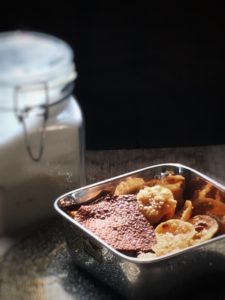Simplicity Coimbatore , Hot salt frying
This is a disclaimer regarding the term ‘FRYING’. It has not been used in technical parlance but rather to convey the idea of applying the concept of crisping up ingredients in a similar manner but without the use of oil. This is for the attention of people involved in Food Technology & Research. The term frying has been loosely used here to denote the purpose of heating salt in the pan.

Before Netlfix, Amazon Prime, Hot star and the rest of it took over our entertainment channels ,the Discovery Travel & Living channel on Star World was something which churned out a whole load of interesting episodes on food and travel.
Planet Food was one such show which was educative, well made and captivating.The hosts had a great sense of humour and made the experience of visiting a particular region so real and not as if it was viewed on television.One of those recipes that was shown involved baking on a bed of salt.
It required no oil,just a thick sheet of damp rock salt in a hot oven. The vegetables roasted beautifully and tasted absolutely great.
A month or so ago,I was sent a Whatsapp video where this lady was roasting free flowing salt in a traditional wok (vadachatti) . She spoke in a typical kongunadu dialect (tamil) while filming a tutorial on how to fry ingredients in hot salt without adding any oil.
I had heard of sand roasting but this was something that I was witnessing for the first time. First she threw in a handful of peanuts which came out beautifully roasted. Then she moved on to things like sun dried vadagam , appalam, kabuli channa and fryums. She also added the colourful javvarisi vadagam which were my favourite as a kid !. One after another the ingredients came out perfectly crisp . She would break or crush each one to show the viewers how well done it was. She also used the same technique with cashew nuts. It seemed like she enjoyed this technique so much and was eager to share it with all. Her enthusiasm was obvious every time she said “romba romba superra irukkum nga”
A few days later we did try it at home with peanuts and they came out great. I have bought sand roasted peanuts ,in the shell ,from vendors who bring their wares to the weekly shandy and have always found them to be perfectly crunchy. This was similar.
After the peanut trial I forgot about the ‘hot salt frying’ until it popped up again on a foodie friend’s instagram story. S If memory serves me right she was frying up mini vadagam in a wide wok, filled half way up with salt. Apparently it was something she picked up from her mother.
The salt we use at home is either a rock salt or sea salt and a Himalayan pink salt. Since I knew that we would not be able to re-use the salt after this experiment,we bought a kilo of free flowing salt just for the frying. (The salt can be re-used for the dry frying but not as seasoning)
It had been awhile since we had fried our favourite ragi appalam and red rice vadagam for lunch. Eating food deep fried in oil is best avoided especially during summer. But this salt frying provided an opportunity to bring out these lunch time favourites. Another plus is that trying something like this is exciting.The beaming smiles from our kitchen helper felt like we were brewing magic standing over a smoking pot !

After placing the well used iron pan on the hob, the salt was tipped in and the flame lit on medium.For 2-3 minutes, we concentrated on tossing the salt back and forth until all the grains were heated uniformly. We started with the small red rice discs and within a few seconds of it disappearing into the mound of salt, we could hear popping sounds. Each disc began to puff in little bubbles and it was done in a few minutes. Getting the cooked vadagam out of the salt required some concentration. Using a slotted ladle with a long handle, quick work was necessary to shake off the excess salt before placing it on the serving platter. Next, in went the dark brown ragi appalam. This was far easier to fish out.
In about 30 seconds after it was done the salt fried food was cool enough to break off and taste. It was not hard or brittle in the least. In fact it was extra crisp and did not feel dry on the tongue despite the lack of oil. The smaller pieces need another sieving to get rid of the fine bits of salt clinging to the ridges.This would probably work better when using coarse sea salt.
This technique is obviously a better alternative to using oil for deep frying.
This method of roasting (frying) in hot salt works only for dried ingredients.

Apparently the sand roasting and salt roasting are common methods employed by street vendors in India, Pakistan and China. They use this method to save on cost. Locally available materials like sand or ingredients like salt offer a wonderful medium, for heat to be distributed, through the fine grains, in a uniform manner. This raises the temperature and the salt also draws out any moisture and puffs up the air pockets inside.
In hot ,arid regions the hot sun would heat up the sand and ingredients would be buried into a pit to be roasted or baked.The desert nomads even baked bread in this manner.
The Italians employ a method referred to as ‘crosta di sale’ where the fish (mostly) is covered in a coating of damp salt and baked. The salt turns hard due to the heat and keeps the inside moist and cooked to perfection.
Rather than pondering if this will add to an unhealthy salt intake, give it a try.Do a small sample test. The excess salt does fall off rather easily. There’s no harm in trying is there ?



No comments yet.